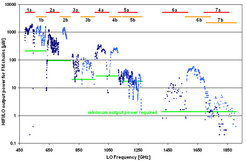The Local Oscillator subsystem

To meet the challenging bandwidth and output power requirements, a new concept of generating a highly stable local oscillator signal has been realized. In general submillimeter local oscillators are configured as cascaded frequency multiplier varactor diode stages fed by a phase locked gunn oscillator at frequencies of 70-115 GHz. The gunn oscillator output power combined with the multiplier efficiency defined the achievable output power, too low to meet the requirements for HIFI. Therefore a development program had started to built a power amplifier module for the frequency range 80-107GHz fed by a synthesizer signal to generate up to 250mW power, sufficient to drive the cascaded frequency multiplier stages. Using this concept the subsystem was built of three units:
- the Source Unit (LSU) providing a synthesized signal in the K-Band (24-35 GHz). The unit is mounted in the service module of the spacecraft at ambient temperature. The work-package holder for this unit is the Canadian Space Agency.
- the Control Unit (LCU) executes the commands received via the instrument control unit and sets all parameters for the operation of the subsystem. The unit is developed by the Space Research Center of Poland.
- the Local Oscillator Unit (LOU) proper is the technically most challenging part of the subsystem. It contains 14 high-frequency signal channels, up-converting the K-band signals from the LSU to the required operating frequencies at 488-1908 GHz
Up-converter chain:

The K-band input signal to the LOU is at first converted to W-band by a frequency tripler. The W-band signal is then amplified by 23 dB (MMIC power amplifier technology developed by TRW/JPL) to provide an output of >200 mW at 71-106 GHz. Subsequent tunerless multiplier stages in cascade convert the W-band to the designed operating frequency of the chain. The required output power ranges from some 100 mW in the lowest frequency channel to 2mW at 1.9 THz.
The development of these critical components is a collaboration between the JPL and MPIfR (and their contractors). The development of the lower 8 multiplier chains is contracted to RPG (Meckenheim), under the direct responsibility of MPIfR.

Optical engineering:

The output signal of each chain is coupled to free-space via horn antennas. A quasi-optical system guides the signal to the optical input ports of the focal plane unit (inside the cryostat). The complex optics design is a MPIfR work package. The layout of the optics design is shown in the left hand figure. The output beams of the two signal chains in each cartridge are focused to an intermediate focal plane, where both are combined by a polarizing grid and then transformed to the optical interface between local oscillator and focal plane unit outside the cartridge. The specifications towards this interface are critical with respect to beam size, beam position, and angular alignment and therefore have been essentially taken into account in the design analyses.
Mechanical engineering:
MPIfR designed and fabricated the mechanical support structure of the LOU, which is constrained by a number of critical design drivers
- the unit is mounted on the outside wall of the spacecraft, in free space. A light-weight mechanical structure is necessary to minimize the unit’s mass.
- the unit is passively cooled to an operation temperature of 120K. A heat load of 6W, dissipated by the power amplifiers, has to be conducted to the spacecraft’s radiator.
- the alignment requirements on the 14 optical signals are extremely tight: any tilt must be less than 0.04° from the nominal propagation axis. The mechanical structure has to provide stability, in cryogenic conditions and after launch (25g acceleration and vibration levels).



